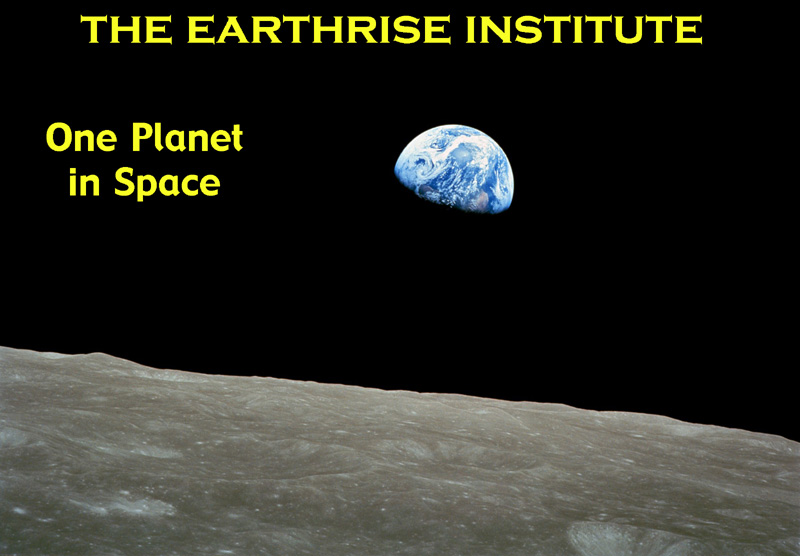
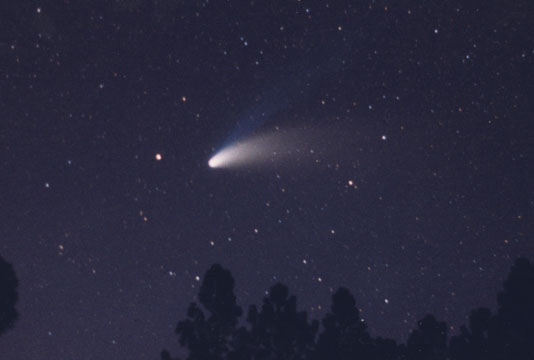
TALLY ENTRIES 721-730
During the early decades of the 20th Century most of the asteroid discoveries, as well as a non-trivial number of the comet discoveries, were made during the course of photographic survey programs being conducted at various observatories around the world. One such effort was conducted by the German astronomers Arnold Schwassmann and Arno Wachmann at Hamburg Observatory in Bergedorf, Germany, who in addition to several asteroids discovered four comets between 1927 and 1930. The first of these comets, 29P/Schwassmann-Wachmann 1, is a most interesting object that travels in a near-circular orbit between the orbits of Jupiter and Saturn and which undergoes outbursts at irregular intervals. I am currently following my fourth "return" of this comet (no. 498), and during the (northern hemisphere's) autumn of 2021 it underwent a series of outbursts which temporarily raised its brightness to 10th magnitude, the brightest it has been in several decades. At present it is just starting to emerge into the morning sky following conjunction with the sun a month ago; it will be at opposition at the very end of this year, and we'll just have to see what kind of activity it exhibits during this coming viewing season.
Schwassmann and Wachmann discovered their last comet in early May 1930, and at the end of that month it passed just 0.062 AU from Earth and reached a peak brightness near 7th magnitude. It was found to have an orbital period as short as 5.4 years, but its low intrinsic faintness combined with a perihelion distance right around 1.0 AU which keeps it hidden in sunlight for months at a time during unfavorable returns caused the next several returns to be missed. It was expected to have a favorable return in mid-1979, however initial searches for it then were unsuccessful. A comet discovered from Perth Observatory in Western Australia in mid-August of that year was soon identified as being this object, although the predicted time of perihelion passage had been off by over a month.
Comet 73P's 1985 return was very unfavorable and it wasn't recovered, however the following return, in 1990 (perihelion mid-May), was relatively favorable, with a closest approach to Earth of 0.37 AU. I followed it for a little over three months (no. 140) and it reached a peak brightness near 10th magnitude.
The viewing geometry during the comet's return in 1995 (perihelion late September) was mediocre at best, especially for the northern hemisphere, and I had no plans to look for it. However, starting around perihelion passage the comet underwent a couple of outbursts which brought its brightness up to as bright as 5th magnitude during October, and it exhibited a bright dust tail almost one degree long which gave it a telescopic appearance of a miniature "Great Comet;" despite its placement fairly low in my southwestern evening sky I ended up following it for four months (no. 202). Towards the end of that period images with larger telescopes revealed four distinct nuclear fragments, and it is obvious that the outbursts were associated with this splitting of the nucleus; it also became clear that the brightest of these fragments, which was designated as "component C," was the primary component.
The comet next returned in early 2001 (perihelion late January) under distinctly unfavorable viewing geometry, but it maintained its enhanced brightness from 1995 and I was able to obtain a handful of observations of component C in late 2000 (no. 284) as a dim object of 12th magnitude at a very low elevation. Images obtained with larger telescopes revealed that component B from 1995 and an additional fragment, designated component E, were accompanying the primary component as separate objects, but I was unable to detect these visually.
Comet 73P's return in 2006 (perihelion early June) was eagerly awaited by the astronomical community, as it would be passing only 0.08 AU from Earth in mid-May and would be visible under excellent viewing geometry. I was able to follow component C for seven months (no. 385) as it reached a peak brightness of 7th magnitude and exhibited a bright dust tail half a degree long. Component B was bright and visible as well, being separated from the primary by as much as seven degrees when they were closest to Earth, and I ended up following it for three months; it exhibited unstable brightness behavior, however, at one point undergoing an apparent outburst and becoming as bright as 6th magnitude when I could faintly detect it with my unaided eye. Numerous additional components also appeared throughout the apparition, and I successfully detected two of these (components G and R) as separate objects (G on a handful of occasions and R once). Images taken by large telescopes, including with the Hubble Space Telescope, revealed that many of the secondary components (including B and G) were themselves fragmenting, and eventually as many as 66 discrete fragments (designated up through component BS) were identified.
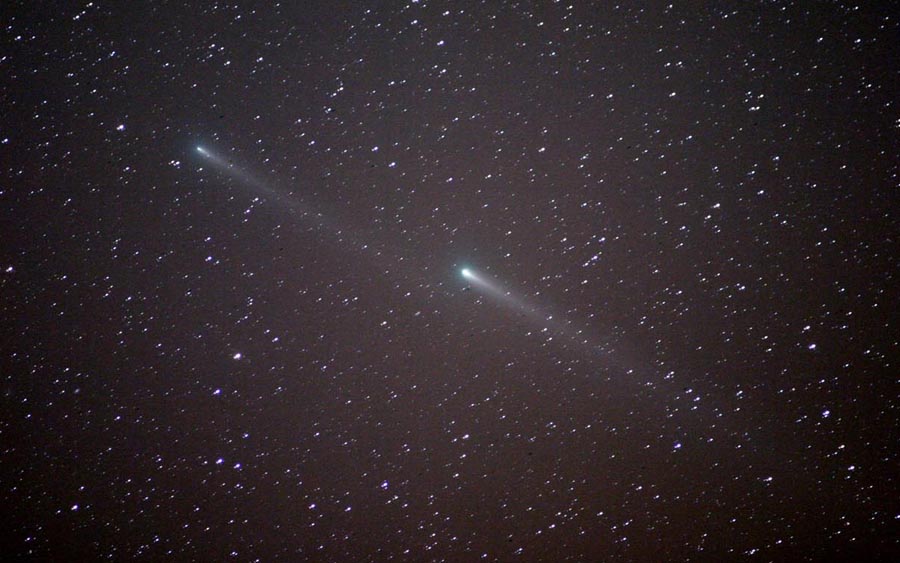
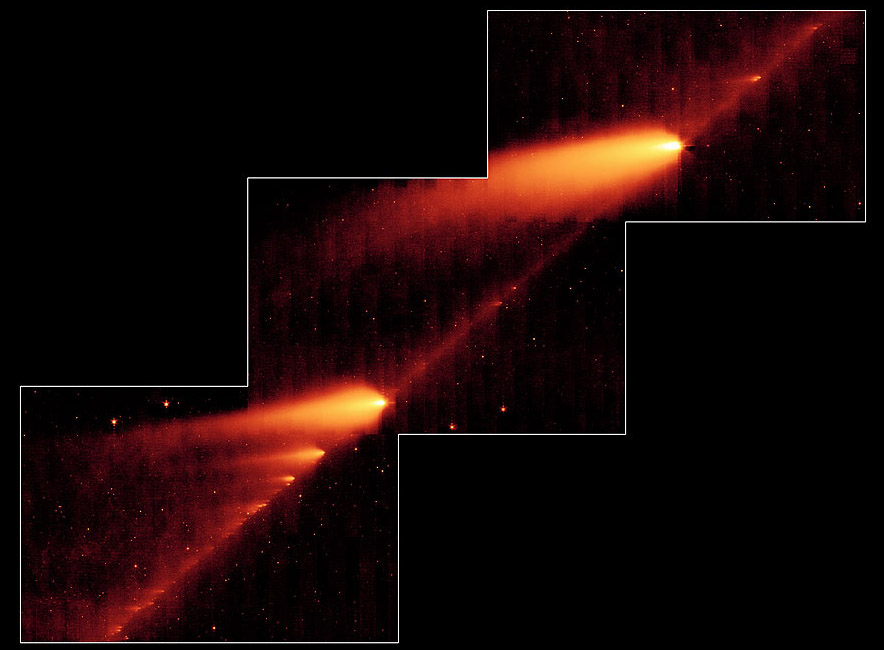 Comet 73P/Schwassmann-Wachmann 3 in 2006 (no. 385). LEFT: Component B (left) and the primary (component C) on June 2. Courtesy John Drummond in New Zealand. RIGHT: Composite infrared image (at a wavelength of 24 microns) obtained between May 4 and 6 by the Spitzer Space Telescope. The primary (component C) is at upper right, component B is towards the lower left, and various additional components as well as an entire train of dusty debris are evident. Courtesy NASA.
Comet 73P/Schwassmann-Wachmann 3 in 2006 (no. 385). LEFT: Component B (left) and the primary (component C) on June 2. Courtesy John Drummond in New Zealand. RIGHT: Composite infrared image (at a wavelength of 24 microns) obtained between May 4 and 6 by the Spitzer Space Telescope. The primary (component C) is at upper right, component B is towards the lower left, and various additional components as well as an entire train of dusty debris are evident. Courtesy NASA.
The primary, component C, has been observed on every return since 2006, but none of the other fragments from that year have been seen since then. The viewing geometry in 2011 (perihelion mid-October) was relatively unfavorable, and although I did look for it on a handful of occasions I was unable to detect it. The following return, in 2017 (perihelion mid-March), was only marginally better, but I nevertheless managed to observe the comet on a handful of occasions (no. 612) low in my southeastern sky before dawn. Curiously, an additional previously-unseen component, designated as component BT, appeared with it, and for a time was even brighter than the primary. I managed to observe this object as well, although neither it nor the primary ever became brighter than magnitude 12 1/2.
On its present return Comet 73P (component C) was recovered as far back as January 13, 2021 by the Lowell Discovery Telescope in Arizona, at which time it was an extremely faint object near 23rd magnitude. Apparently there were no further observations made for over a year, but beginning in late January 2022 (when it was near 19th magnitude) it has been imaged regularly around the world as it has approached perihelion and brightened; it went through opposition in late February. I took a set of images with the Las Cumbres Observatory network shortly after mid-June, and these suggested the comet was bright enough to attempt visually, however when I was able to make such an attempt near the end of June I couldn't detect anything convincing. (A monsoon season which began early this year has made clear nights relatively few and far between for the past few weeks.) An additional set of LCO images that I took in mid-July suggested that the comet had become distinctly brighter, and on the evening of the 16th I successfully detected it as a small and relatively condensed object slightly fainter than magnitude 12 1/2.
The geometry of the present return could perhaps be described as "moderately favorable," although this primarily applies to observers in the southern hemisphere; for those of us north of the Equator, it is only accessible low in the southwestern sky after dusk since it remains south of the sun until early December. At present it is located in far western Virgo (at an elongation of 57 degrees) just over three degrees north of the star Beta Virginis, and is traveling towards the east-southeast at approximately 50 arcminutes per day. As the comet approaches both the sun and Earth its motion increases, reaching a maximum of 80 arcminutes per day in late September, at which time it is near its closest approach to Earth (0.97 AU) and also when its declination goes south of -30 degrees (reaching a peak just south of -36 degrees in mid-October). Throughout this interval it travels through Virgo (passing just over 20 arcminutes south of the bright star Spica on August 21) then enters Libra in early September and Scorpius shortly before the end of that month, passing one degree south of the large open star cluster M7 on October 11 before crossing into Sagittarius a day later, where it remains before finally crossing into Microscopium in early November.
If the comet behaves more or less "normally," it should brighten by perhaps a magnitude to a magnitude and a half over the next few weeks, thus reaching a peak brightness near 11th magnitude in late August and early September. It is always possible, based upon its past behavior, that it could undergo outbursts or other activity during this time, and meanwhile, although thus far there haven't been any reports of additional companions, the possibility remains that one or much such objects could appear. In any event, based upon its poor placement in the northern hemisphere's sky, our ongoing monsoon season here in New Mexico, and my general slowdown in observational activity, at best I will likely obtain only a handful of additional observations of the comet.
Comet 73P's cascading episodes of fragmenting in 2006 and the debris stream it exhibited then led to speculation that Earth might witness a meteor shower this year, probably occurring in late May and coming from a radiant near the star Tau Herculis. Accurate predictions for any such shower were difficult to make, in significant part because it would have to be due to debris leading the comet, as opposed to debris trailing the comet as is usually the case with most showers. It turns out that a shower did occur, on the night of May 30-31 and best visible from North America, although it was brief and not especially strong, with a peak zenithal hourly rate of 30 to 40 meteors per hour. During a brief watch that night -- from my front porch, where a non-trivial fraction of my observable sky is obscured -- I did manage to see a handful of meteors from this shower.
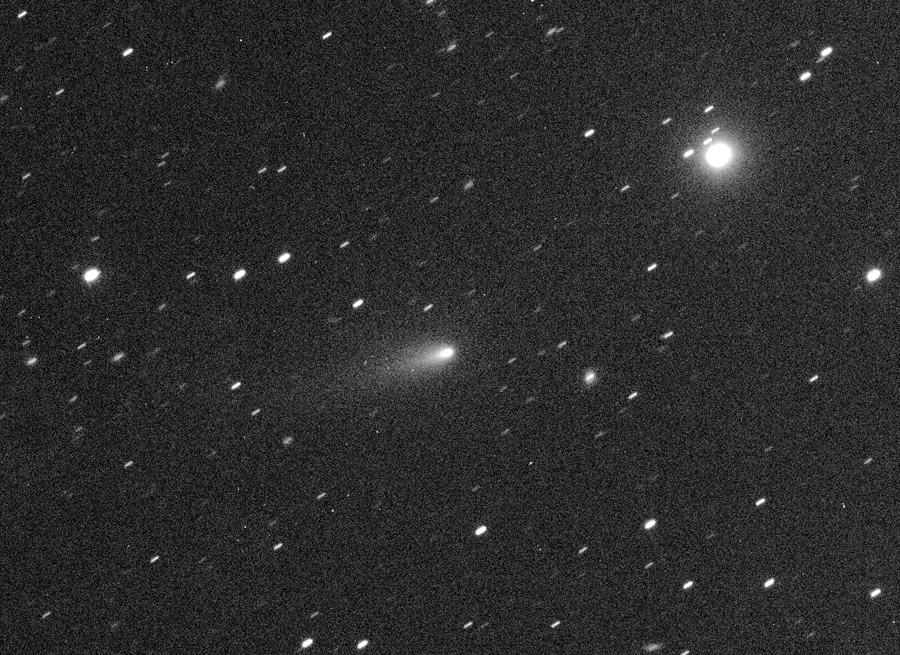
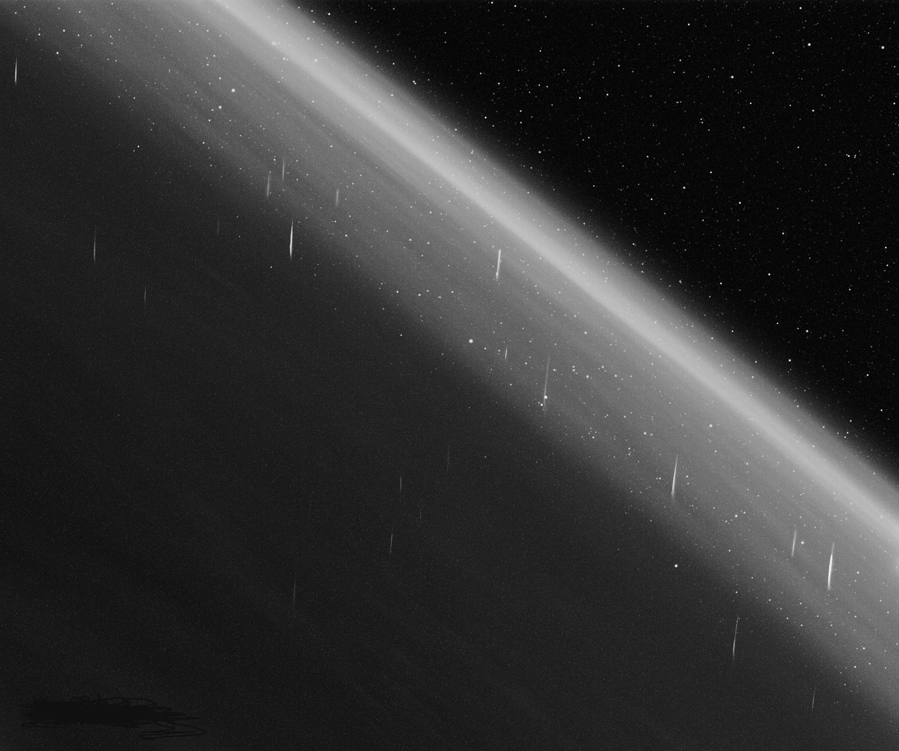 LEFT: An image of Comet 73P/Schwassmann-Wachmann 3 I took via the Las Cumbres Observatory facilty at Haleakala Observatory in Hawaii on July 15, 2022, slightly less than two days before my first visual observation. RIGHT: The Tau Herculid meteor shower on May 31, 2022, as seen from space: this five-minute exposure was taken by the Yangwang-1 Space Telescope launched in 2021 by the private Chinese firm Orbital Space. Courtesy Zhouxiao Wang and Orbital Space.
LEFT: An image of Comet 73P/Schwassmann-Wachmann 3 I took via the Las Cumbres Observatory facilty at Haleakala Observatory in Hawaii on July 15, 2022, slightly less than two days before my first visual observation. RIGHT: The Tau Herculid meteor shower on May 31, 2022, as seen from space: this five-minute exposure was taken by the Yangwang-1 Space Telescope launched in 2021 by the private Chinese firm Orbital Space. Courtesy Zhouxiao Wang and Orbital Space.
As is the case for many of the other "old friend" periodic comets that I have been observing lately, this will very probably be the last return during which I will observe Comet 73P. The next return, in 2027 (perihelion late December), is very unfavorable, but the one after that, in 2033 (perihelion early May), is a relatively good one, somewhat reminiscent of that of 1990; as I have indicated in numerous previous entries, however, I will likely have ceased visual comet observing well before then. The comet will make additional close approaches to Earth in 2054 (0.20 AU) and in 2070 (0.12 AU), but I will leave any observations to the comet observers of those eras.
INITIAL OBSERVATION: 2022 July 17.16 UT, m1 = 12.7, 0.6' coma, DC = 5 (41 cm reflector, 70x)
UPDATE (August 8, 2022): Austrian amateur astronomers Michael Jaeger and Lukas Demetz have discovered two new fragments of Comet 73P, designated as components BU (first detected July 23 although not noticed until the following day) and BV (also first detected July 23), utilizing a remotely-controlled telescope located in Namibia. Both components are leading the primary component by approximately 16 to 22 arcminutes and are both about 19th magnitude, each with a coma approximately 10 arcseconds in diameter and a tail slightly less than an arcminute long. Preliminary orbital calculations indicate that they will pass perihelion roughly 20 hours prior to the primary component. At this time it is too early to tell when they may have separated from the primary, and in all likelihood neither one will probably survive for much longer.
Because of our continuing monsoon here in New Mexico and the comet's low placement in our southwestern sky (which in turn creates only a very short observing window after dusk), and now moonlight as well, I have not seen Comet 73P again since my initial observation on July 16. Since it will only be getting lower during the coming weeks it is entirely possible that that initial observation will remain my only observation this time around, and thus more than likely would be the final observation I ever make of this comet.
UPDATE (September 7, 2022): In mid-August -- specifically, August 13 and 14 -- Michael Jaeger and Lukas Demetz, together with fellow Austrian amateur astronomer Gerald Rhemann, reported their discoveries of three additional fragments of Comet 73P, since designated as components BW through BY. Component BW was located just over an arcminute northwest of the primary (i.e., trailing it) and was very faint, near 20th magnitude; BX was about a magnitude brighter and located some 13 arcminutes ahead of the primary, and component BY, the brightest of the three, was located almost 50 arcminutes ahead of the primary and initially near magnitude 17.5. All of these objects, as well as the two fragments detected in July, have apparently all but disintegrated by now, although it is always possible that even more additional fragments might be detected during the days and weeks to come.
My initial observation of the comet in mid-July remains my only observation of it during the current return, and since from my location it is less than 10 degrees above the horizon at the end of astronomical twilight and continues traveling southward during the coming weeks that will likely remain the case. Based upon reports I have read from the southern hemisphere it appears that the comet reached 12th magnitude around the time of perihelion passage.
UPDATE (October 13, 2022): As I have indicated in the previous updates, I have honestly felt that my initial observation of this comet back in mid-July would remain my only observation of it during the current return. For the most part it has remained all but inaccessible from my latitude for the past couple of months, and although it is now starting to become accessible again the fact that it is now a month and a half past perihelion would suggest that it has faded beyond the range of worthwhile visual attempts. Indeed, the recent reports I have seen have suggested that it was no brighter than about 14th magnitude.
However, on October 12 I saw an image taken three days earlier by French amateur astronomer Jean-Louis Virlichie (remotely from Chile) that indicated that the comet was apparently much brighter, around 10th to 11th magnitude. A pair of images I took later that day via the Las Cumbres Observatory facility at Cerro Tololo Inter-American Observatory in Chile seemed to support this, and meanwhile, although I was unaware of this at the time, some other observers -- including a group utilizing the TRAPPIST remote telescope in Chile -- were recording an apparent recent outburst (up to four magnitudes or more). In any event, despite the fact that it is currently located at a declination of -36 degrees and was only 15 degrees above my southwestern horizon, I successfully detected the comet visually that evening as a moderately condensed object of magnitude 11 1/2.
Comet 73P is presently located in southwestern Sagittarius about two degrees west-northwest of the star Eta Sagittarii and is near its farthest south point; for the time being it is traveling due eastward at roughly 75 arcminutes per day, gradually slowing down and curving towards the east-northeast over the coming weeks. Some of the available evidence suggests that the outburst is already subsiding, so the comet will likely not remain visually detectable for much longer; I am cautiously optimistic that I might be able to obtain one, conceivably two, additional observations of it before it fades beyond visual range.
Given its history and the recent fragmenting that I've discussed in the previous updates, it is not surprising that Comet 73P has undergone a recent outburst like this one. There will likely be more additions to this comet's story by the time all is said and done . . .
MOST RECENT OBSERVATION: 2022 October 13.07 UT, m1 = 11.5, 1.4' coma, DC = 4-5 (41 cm reflector, 70x)
722. COMET ZTF C/2022 E3 Perihelion: 2023 January 12.78, q = 1.112 AU
In the entry for my first "Comet ZTF" (no. 720) I mentioned this incoming comet. It was discovered by the Zwicky Transient Facility survey in California on March 2, 2022, at which time it was described as a 17th-magnitude apparently asteroidal object located in the morning sky at an elongation of 47 degrees. Japanese amateur astronomer Hidetaka Sato managed to take a pair of images the following morning utilizing a remotely-controlled telescope in New Mexico that showed weak cometary activity. It was apparently lost after that, as there were no further observations for the next two weeks, but the ATLAS survey in Hawaii finally picked it up on March 18 (at which time the moon was full), and thereafter numerous observations began to be reported from around the world. I managed to obtain a couple of images of it on March 20 with the Las Cumbres Observatory (LCO) facility at Teide Observatory in the Canary Islands, and the astrometric measurements I made from these are among those included on the comet's discovery announcement that went out the following day.
The comet has traveled northward and has gradually brightened since its discovery, and went through opposition in early July. I've obtained occasional LCO images during the interim, and meanwhile some recent images I've seen -- which show the development of a distinct dust tail -- and various other reports have indicated that it is now bright enough to attempt visually. During a brief respite from our summer monsoon here in New Mexico, on the evening of July 23 I successfully detected it as a small and condensed object of magnitude 13 1/2 that exhibited distinct motion against the background stars in as little as 10 minutes.
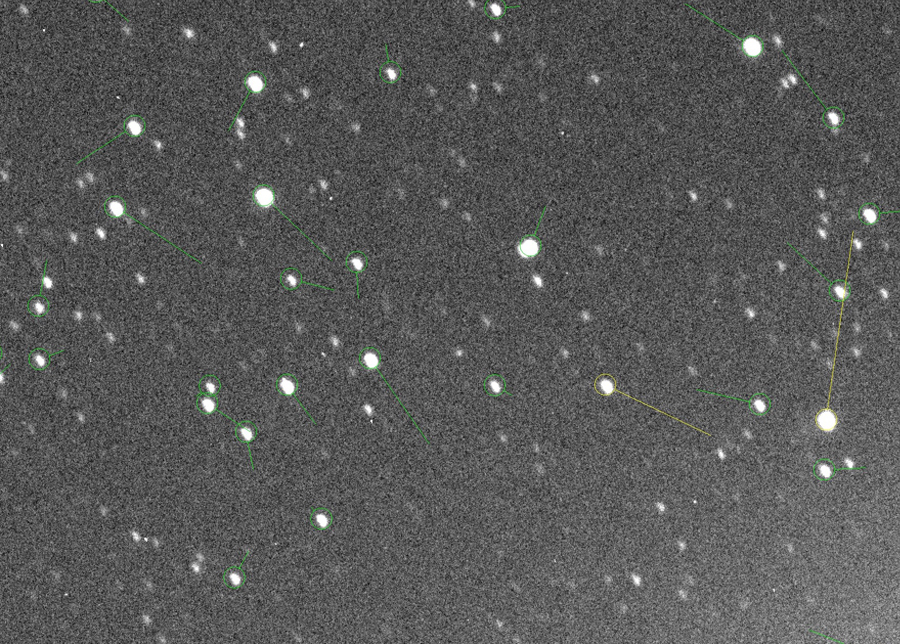
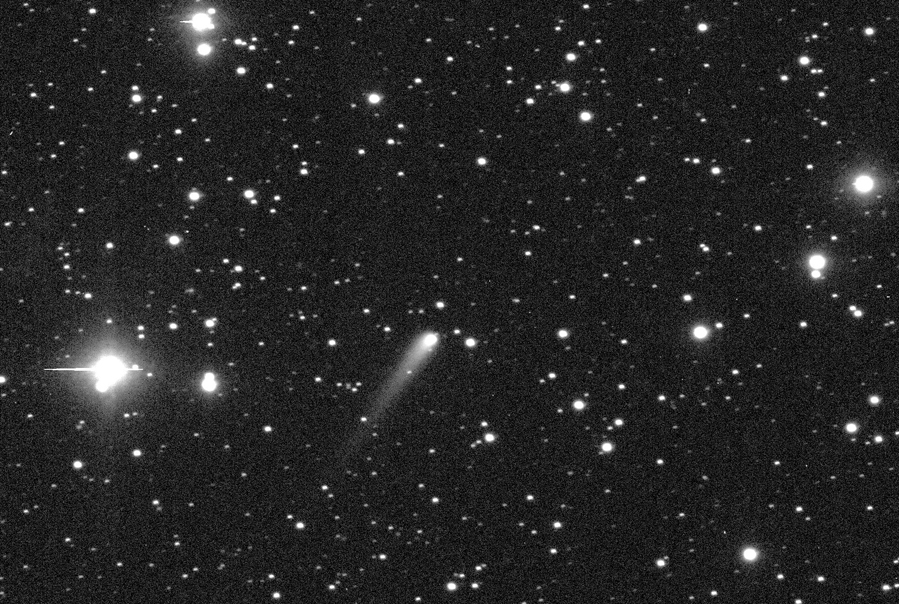 Images of Comet ZTF I've obtained via the Las Cumbres Observatory (LCO) network. LEFT: "Stacked" images (total exposure time 10 minutes) taken from the LCO facility at Teide Observatory in the Canary Islands on March 22, 2022. The comet is the small, essentially starlike object in the center. RIGHT: A single 3-minute exposure I took via the LCO facility at McDonald Observatory in Texas on July 24, 2022, two hours after my first successful visual observation.
Images of Comet ZTF I've obtained via the Las Cumbres Observatory (LCO) network. LEFT: "Stacked" images (total exposure time 10 minutes) taken from the LCO facility at Teide Observatory in the Canary Islands on March 22, 2022. The comet is the small, essentially starlike object in the center. RIGHT: A single 3-minute exposure I took via the LCO facility at McDonald Observatory in Texas on July 24, 2022, two hours after my first successful visual observation.
Comet ZTF is traveling in a steeply-inclined retrograde orbit (inclination 109 degrees) and is presently located in eastern Hercules some three degrees southwest of the star Theta Herculis, traveling due westward at slightly over half a degree per day; it crosses the "Keystone" of that constellation from August 10 through the 22nd (passing two degrees south of the bright globular star cluster M13 on the latter date) and then crosses into Corona Borealis in early September. After that it begins a gradual turn towards the south, crossing into Serpens Caput during the latter part of October and being at its stationary point in early November; shortly after the middle of that month it is in conjunction with the sun (44 degrees north of it).
After it re-emerges into the morning sky afterwards the comet begins traveling almost due northward through Corona Borealis, Bootes, and Draco, entering northern circumpolar skies during the latter part of January 2023 and reaching its farthest north point (declination +80.3 degrees) on January 30 when it crosses into Camelopardalis. It is closest to Earth (0.284 AU) on February 1, when it will be located near a declination of +71 degrees and traveling towards the west-southwest at slightly over 6 1/2 degrees per day. Afterwards it starts slowing down and begins traveling almost due southward through Auriga, Taurus (passing three degrees east of the center of the Hyades star cluster on February 15), and (beginning in early March) Eridanus. In late April the comet crosses into Lepus, is in conjunction with the sun (42 degrees south of it) around the time of the June solstice, and over the next couple of months gradually starts emerging into the southern hemisphere's morning sky, although by then it will be a distant and (likely) dim object.
As I indicated in the earlier entry, this Comet ZTF's relatively close approach to Earth early next year suggests the possibility that it could become visible to the unaided eye, although as is always the case with previously-unseen long-period comets brightness predictions can be problematical. A couple of encouraging signs for this comet are the fact it is already exhibiting a distinct dust tail (at least, on CCD images), and the fact it appears not to be a "new" comet from the Oort Cloud, the most recent calculations indicating a previous return approximately 48,000 years ago. A cautiously optimistic scenario suggests the comet should reach visibility in ordinary binoculars by sometime in December 2022, and will be a naked-eye object of perhaps 5th magnitude -- conceivably, 4th magnitude -- around the time of its closest approach to Earth. For observers in the northern hemisphere it will be conveniently located in far northern skies at that time, although unfortunately moonlight will interfere (full moon being on the night of February 5-6). After its passage by Earth the comet will likely fade fairly rapidly, dropping below binocular visibility by perhaps mid-March.
While there is no reason to expect Comet ZTF will be a "Great Comet," it appears that we should at least have a somewhat bright comet that will briefly grace our skies in early 2023. It will likely be one of the last naked-eye comets, although hopefully not the very last such object, that I will observe before the "retirement" that I have discussed so much in previous entries.
I add this particular comet to my tally under somewhat bittersweet personal circumstances. My older son Zachary is relocating back to Australia (where he lived for four years previously, although he has been back here in New Mexico for the past two years), perhaps indefinitely. With my current health issues, my ability to travel any significant distance is limited, and while I suppose it is theoretically possible that I might travel to Australia again (especially if a very bright comet or other notable astronomical event appears which is only visible from the southern hemisphere), I consider it very unlikely that I will do so, thus any future occasions when I might see him again will almost certainly be restricted to those times when he visits back here. I can only wish him well on his future endeavors.
INITIAL OBSERVATION: 2022 July 24.15 UT, m1 = 13.5, 0.4' coma, DC = 7 (41 cm reflector, 70x)
UPDATE (December 3, 2022): I managed to follow Comet ZTF in the evening sky until almost the end of October, by which time it had brightened to about 11th magnitude. The distinct dust tail that is prominent on CCD images was also detectable visually, and for the last few weeks prior to the comet's disappearance into evening twilight I was usually measuring lengths of 3 to 4 arcminutes. After its conjunction with the sun I first picked it up in the morning sky on December 2 (just after it cleared the trees to my northeast around the beginning of dawn); it had brightened further to 10th magnitude, and I could detect the somewhat broad and gently curved dust tail out to a length of about 7 arcminutes. Although the tail wasn't especially bright, it nevertheless gave the comet an overall appearance that was actually rather impressive.
Comet ZTF is currently located in northeastern Serpens Caput one degree south-southeast of the star Delta Coronae Borealis and is traveling northward at a present rate of just over 5 arcminutes per day, although this pace will pick up during the coming weeks as the comet approaches perihelion and Earth. In terms of its brightness the comet appears to be running slightly behind the scenario I described above, although not dramatically so, so it may still reach naked-eye brightness -- perhaps 6th magnitude -- around the time of its closest approach to Earth in early February. I'm more inclined to believe that, instead, we'll have a bright binocular comet to observe then, and if it continues to exhibit the distinctive dust tail that it has thus far it could be a rather impressive object. We'll see what happens . . .
MOST RECENT OBSERVATION: 2022 December 2.52 UT, m1 = 10.2, 2.7' coma, DC = 3-4, 7' tail in p.a. 055 (41 cm reflector, 70x)
UPDATE (January 28, 2023): Comet ZTF has brightened rather nicely as it approached and passed through perihelion and subsequently continued its approach to Earth, being near 7th magnitude in early January, near 6th magnitude shortly after the middle of the month, and being a relatively easy naked-eye object near magnitude 4 1/2 when I observed it this morning. In numerous images I have seen it has also displayed some rather dramatic tail structure, including a distinct anti-tail when Earth crossed its orbital plane on January 23, although unfortunately due to poor weather at the time I missed seeing that event. It has since become part of a broad fan that is easily seen telescopically and faintly detectable in binoculars.
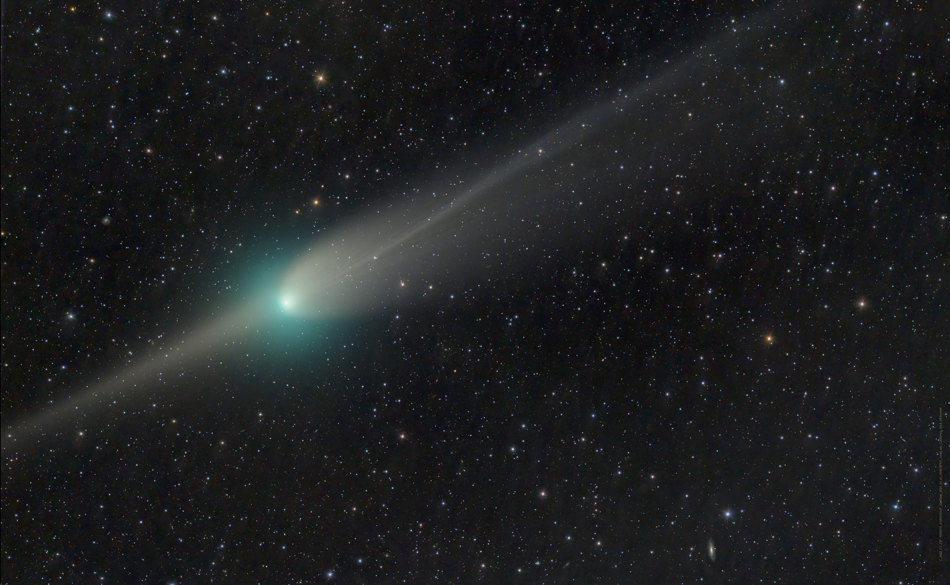
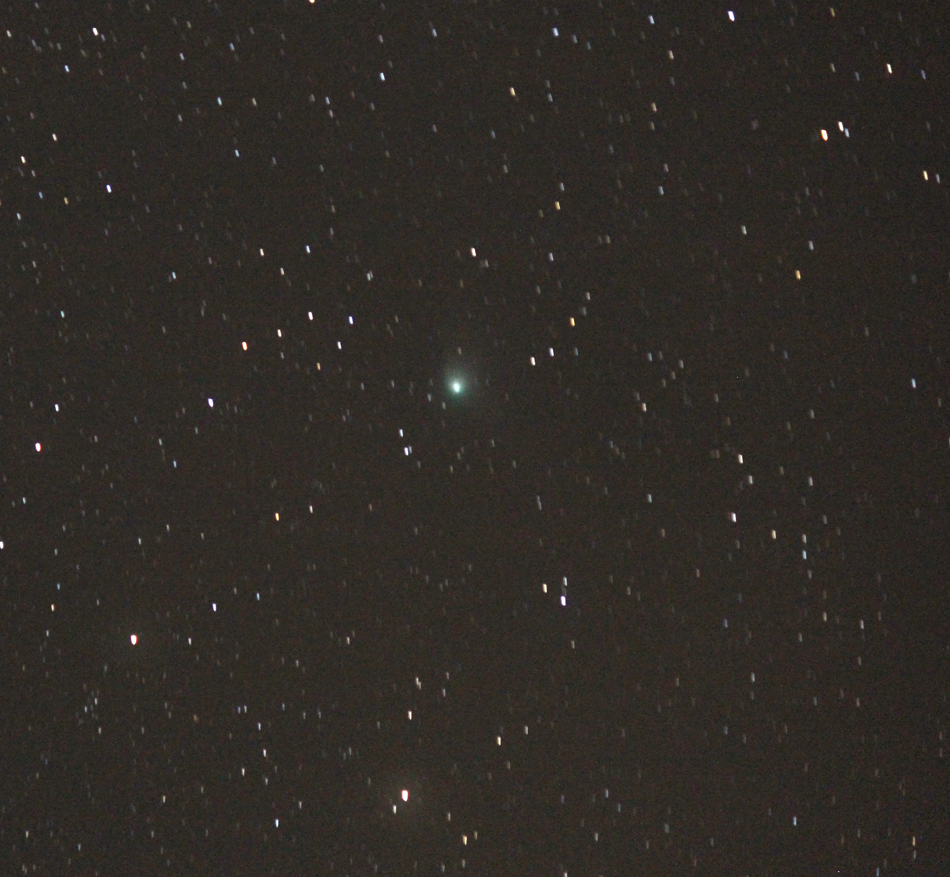 LEFT: Image taken by Dan Bartlett in California on January 23, 2023, around the time that Earth crossed through the comet's orbital plane. Courtesy Dan Bartlett. RIGHT: A photograph I took on the morning of January 28, 2023. This approximates the comet's appearance through 10x50 binoculars.
LEFT: Image taken by Dan Bartlett in California on January 23, 2023, around the time that Earth crossed through the comet's orbital plane. Courtesy Dan Bartlett. RIGHT: A photograph I took on the morning of January 28, 2023. This approximates the comet's appearance through 10x50 binoculars.
At this writing we are just a few days away from Comet ZTF's closest approach to Earth, although moonlight will begin to interfere with observations within the not-too-distant future. By the time the moon clears from the evening sky during the second week of February the comet will likely have begun fading, although hopefully it will still be close to naked-eye visibility for perhaps another week or two after that.
MOST RECENT OBSERVATION: 2023 January 28.30 UT, m1 = 4.6, 20' coma, DC = 4-5 (naked eye)
723. COMET PANSTARRS C/2020 K1 Perihelion: 2023 May 9.09, q = 3.073 AU
As I continue to slow down my observational activities I normally wouldn't pay much attention to dim, distant, nondescript long-period comets like this one. However, it is presently located in the same general part of the sky as Comet PANSTARRS C/2017 K2 (no. 699) -- currently around 9th magnitude, which although somewhat fainter than expected is nevertheless the only moderately bright comet presently visible in the nighttime sky -- and since recent reports I've read and images I've seen suggested it might be bright enough to detect visually, I decided to give it a try during a recent clear night, and successfully detected it.
The Pan-STARRS survey in Hawaii discovered this comet on May 17, 2020, at which time it was a very dim object of 20th magnitude and located fairly high in northern skies near a declination of +58 degrees. Orbital calculations soon showed that it was located 9.5 AU from the sun and was almost three years away from perihelion passage, and that it is traveling in an orbit almost exactly perpendicular to Earth's. It has traveled southward and slowly brightened since then, and most recently went through opposition in late June 2022. After completing my observation of Comet C/2017 K2 on the evening of August 15 -- one of the very few clear, dark nights we have had in these parts recently -- I was able to detect it as a small, somewhat diffuse, moderately condensed object of 13th magnitude.
Comet PANSTARRS is currently located in northern Ophiuchus about 1 1/2 degrees southwest of the star Sigma Ophiuchi, and is traveling towards the south-southwest at just over 15 arcminutes per day; over the next few weeks it curves more directly southward and passes through its stationary point in mid-September. It remains accessible in the evening sky for perhaps another month after that, although it will probably stay fairly close to its present brightness; I may observe it another one or two times before it disappears into the dusk.
After that, the comet is gone as far as I and other northern hemisphere observers are concerned. After being in conjunction with the sun in late December it starts emerging into the morning sky around February 2023, however it will only be visible from the southern hemisphere at that time. The comet continues traveling southward, entering southern circumpolar skies in early May and coming within 1 1/2 degrees of the south celestial pole in early July. It is closest to Earth (2.47 AU) in early June, and throughout this time should be a rather easy object for observers in the southern hemisphere, being perhaps one to two magnitudes brighter than it is now. Meanwhile, although it (temporarily) starts to travel back northward, it remains in southern circumpolar skies for quite some time thereafter, and in fact it again approaches just three degrees from the south celestial pole in mid-December. After that Comet PANSTARRS begins a gradual trek towards more northerly skies and accessibility again from the northern hemisphere (albeit still quite low in the southern sky); when at opposition in late December 2024 it will be near a declination of -41 degrees. By that time, however, it should be far too faint for visual observations, and in any event I will very likely be all but finished with regular visual observational activities.
INITIAL OBSERVATION: 2022 August 16.16 UT, m1 = 13.2, 0.4' coma, DC = 4-5 (41 cm reflector, 229x)
724. COMET NEOWISE C/2022 P1 Perihelion: 2022 November 28.47, q = 1.595 AU
Although it is perhaps not as prolific as some of the other currently-operating survey programs, ever since it commenced operations nine years ago the NEOWISE mission has nevertheless contributed a reasonable share of discoveries of near-Earth asteroids, as well as several comets; this is its 23rd comet discovery, and the 9th of those that I have observed. NEOWISE discovered this comet as a 17th or 18th magnitude object on August 8, 2022, and as part of follow-up efforts I was able to obtain some images via the Las Cumbres Observatory network five days later; my astrometric measurements from these are among those included on its discovery announcement. Orbital calculations have shown that the comet is traveling in a shallowly-inclined retrograde orbit (inclination 155 degrees, i.e., 25 degrees from the ecliptic plane), and it appears to be a Halley-type object with an orbital period slightly in excess of 80 years. It and Earth are currently "passing by" each other going in opposite directions, with a minimum distance of 0.85 AU taking place on September 25, at which time it will also be near opposition.
By late August various images and reports, including at least one visual report, indicated that Comet NEOWISE was beginning to exhibit a faint, large, diffuse outer coma and was brightening rapidly. Due to our continuing monsoon season here in New Mexico I had to wait a while before I had a clear night, but I finally had one on the early morning of September 5, and I successfully detected the comet as a vague, diffuse, and uncondensed object of 13th magnitude.
Comet NEOWISE is currently located in central Cetus roughly 5 degrees west-southwest of the famous variable star Mira (which had its most recent maximum about two months ago), and is traveling towards the southwest at a present rate of 1 1/2 degrees per day. Its motion accelerates as it approaches Earth, and when closest approach occurs it will have entered Sculptor and will be near a declination of -27 degrees and traveling at 2 1/4 degrees per day. Although it does start to slow down as it pulls away from Earth it continues traveling southward, crossing into Grus in early October and into Microscopium near the middle of that month, where it reaches a maximum southerly declination of -42.4 degrees a week later. Shortly before the end of October the comet crosses into Sagittarius, where it remains until disappearing into twilight within another month.
Ostensibly, Comet NEOWISE should brighten by perhaps a magnitude or so by the time it is nearest Earth in late September, maintaining this peak brightness for a couple of weeks before beginning a gradual fading as it recedes from Earth but continues to approach perihelion. However, it is not unheard-of for Halley-type comets to exhibit "unconventional" behavior, and thus it is conceivable that it might brighten further and/or more rapidly than this scenario might suggest; nevertheless, I would be surprised if it became any brighter than about 11th magnitude, and I certainly don't expect anything brighter than 10th magnitude.
While its exact orbital period still remains to be nailed down, it appears that Comet NEOWISE would have previously returned to perihelion sometime around 1940. Once we do have a more accurate determination of its orbital period it is at least theoretically possible that images of it might be found on photographs taken around that time, which of course would permit an even better determination of its orbit and which would also allow it to receive a permanent number. Meanwhile, its next return would be taking place in the early years of the 22nd Century, and it is difficult to imagine just what our world, and our society, will be like for our descendants of that era.
INITIAL OBSERVATION: 2022 September 5.31 UT, m1 = 12.9, 1.8' coma, DC = 1 (41 cm reflector, 70x)
725. COMET P/DIDYMOS P/(65803) Perihelion: 2022 October 21.80, q = 1.013 AU
In previous entries I have discussed my rationale for including "active asteroids" -- regardless of the mechanism that produced the "activity" in question -- as "comets" on my tally. I am now adding an additional such object, although I concede that I am perhaps stretching the concept of "active asteroid" a bit in this case.
This particular object was originally discovered on April 11, 1996 by Joe Montani with the Spacewatch program in Arizona, and was deginated 1996 GT. It has since been found to be an Amor-type near-Earth asteroid with a perihelion distance just outside Earth's orbit, and traveling in a low-inclination (3.4 degrees) moderate-eccentricity (0.38) orbit with a period of 2.11 years; at the time of its discovery it was almost a year past perihelion passage and in fact was only a little over two months from aphelion. After being followed for five weeks it was recovered on two nights in early 1998, and after being observed again on various occasions each year from 2000 through 2003 it was assigned the permanent number (65803).
The following year (65803) 1996 GT was given the name "Didymos," from the Greek word for "twin." More recently, two years ago Didymos' moon was given the name "Dimorphos," from the Greek word for "having two forms."
Several years ago the Didymos system was selected as the destination for NASA's Double Asteroid Redirection Test (DART) mission. DART was developed as a test of using a kinetic impact to deflect a potential incoming asteroid from striking Earth; in this instance, an impact into Dimorphos would, if successful, change its
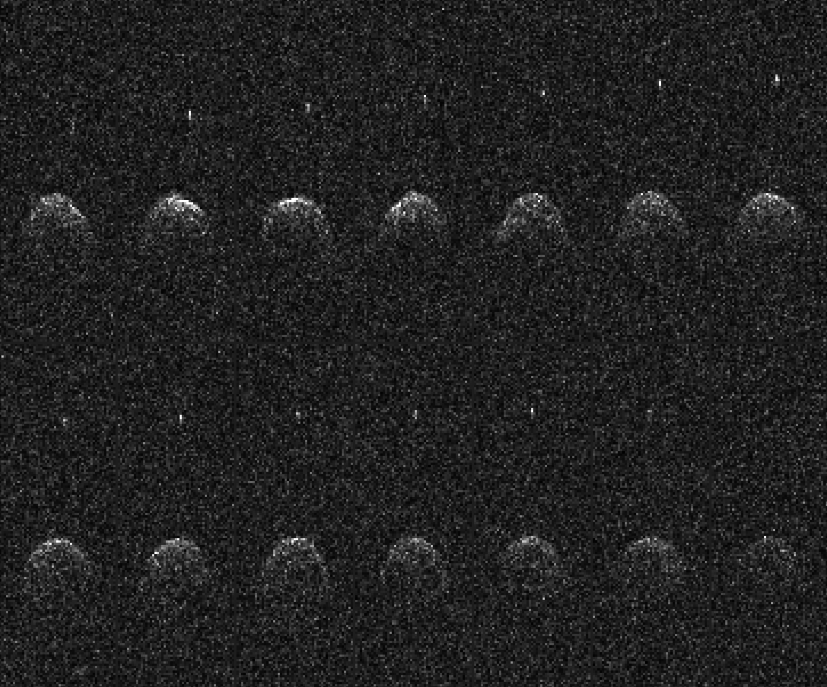
orbit around Didymos by a small amount. (Given enough lead time for a potential incoming asteroid, a tiny change in its orbital motion years in advance would be all that is necessary to deflect it from impacting Earth.)
Didymos is currently making another close approach to Earth (minimum distance 0.071 AU on October 4, 2022). DART, meanwhile, was launched from Vandenberg Space Force Base in California on November 24, 2021, and after arriving at the Didymos system on September 26, 2022 successfully impacted Dimorphos. At this writing it is too early to tell whether or not the impact affected Dimorphos' orbital motion enough to consider this a successful test of this particular asteroid deflection technique; this question should be answered by observations of that motion that will be made over the coming few weeks. Meanwhile, the impact generated a large plume of dust that was ejected off Dimorphos' surface and into the surrounding space; this was captured spectacularly by the accompanying Italian Space Agency's Light Italian CubeSat for Imaging of Asteroids (LICIACube) spacecraft and has also been detectable by ground-based telescopes. Various observations indicated that the overall brightness of the Didymos system increased rather dramatically after the impact, and in the days since then the ejected dust has created some interesting tail-like structure that is somewhat reminiscent of other "active asteroids" that have been seen in the past.
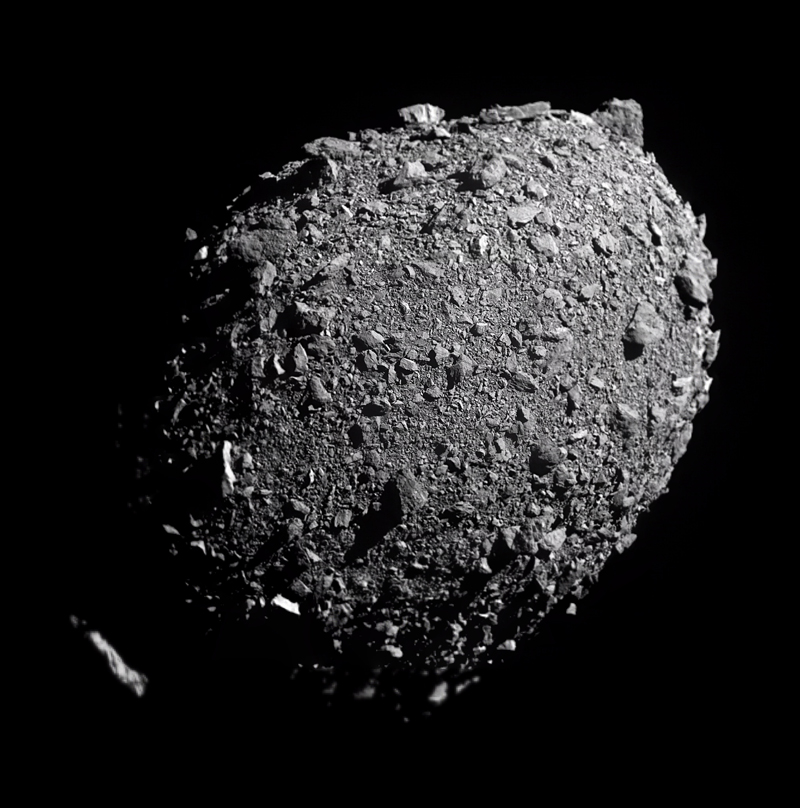
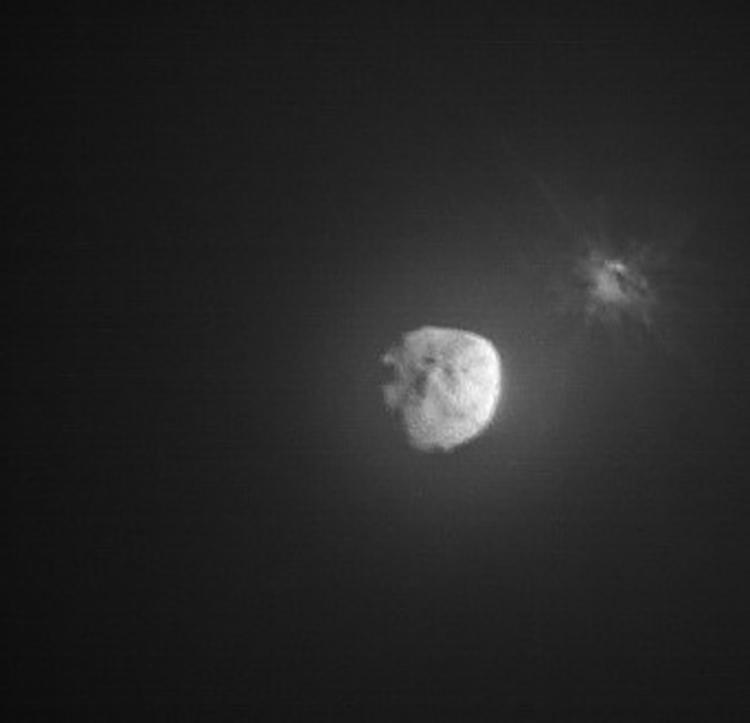 LEFT: DART image of Dimorphos, taken just a few seconds before impact. The impact took place within the arc of three large boulders near the center of the image. Courtesy NASA. RIGHT: Didymos (near center) and Dimorphos (right) as imaged by the Italian Space Agency's LICIACube spacecraft shortly after the DART impact. Courtesy Italian Space Agency (ASI)/NASA.
LEFT: DART image of Dimorphos, taken just a few seconds before impact. The impact took place within the arc of three large boulders near the center of the image. Courtesy NASA. RIGHT: Didymos (near center) and Dimorphos (right) as imaged by the Italian Space Agency's LICIACube spacecraft shortly after the DART impact. Courtesy Italian Space Agency (ASI)/NASA.
I had no specific plans to observe Didymos, however after seeing the various images and reading reports of its post-impact appearance I decided to give it a try. On the morning of September 30 -- 3 1/2 days after the DART impact -- I successfully detected Didymos and followed it for just under half an hour. It appeared just fainter than magnitude 13 1/2 -- a full magnitude brighter than the ephemeris prediction -- and while its overall appearance was stellar, I seemed to detect a very faint, vague amorphous "coma," of sorts, around it. I could never quite convince myself of this feature's reality one way or the other, although it is reasonably consistent with some of the images I have seen.
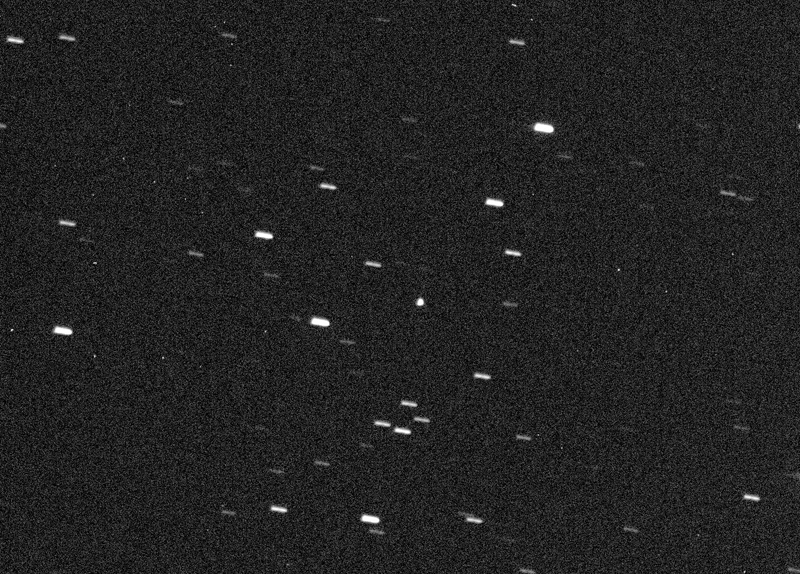
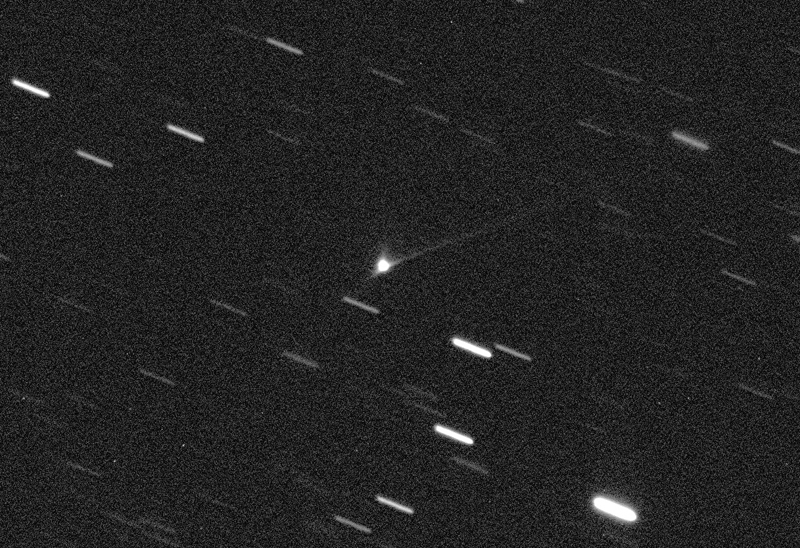 "Before" and "after" images of (65803) Didymos, obtained via the Las Cumbres Observatory facility at Cerro Tololo Inter-American Observatory in Chile. LEFT: September 24, 2022. RIGHT: September 30, 2022, roughly 3 1/2 days after the DART impact and two hours before my visual observation.
"Before" and "after" images of (65803) Didymos, obtained via the Las Cumbres Observatory facility at Cerro Tololo Inter-American Observatory in Chile. LEFT: September 24, 2022. RIGHT: September 30, 2022, roughly 3 1/2 days after the DART impact and two hours before my visual observation.
At present Didymos is located in northeastern Eridanus and is traveling towards the east-northeast at slightly under three degrees per day (slowing to one degree per day by the end of October). Over the course of the next month it crosses through Lepus, Canis Major, Monoceros and Canis Minor, and passes just over a degree south of the bright star Procyon on October 30. Under ordinary circumstances it would presently be near its maximum brightness and would fade by over a magnitude by the end of October as it pulls away from Earth, however its true brightness behavior may be more complicated than that; it still will likely fade over the course of the next few weeks. I may, or may not, look for it again.
Didymos does not make a close approach to Earth again until October 2062, when it will pass 0.050 AU from our planet. Within the not-too-distant future, however, we Earthlings should get another decent view of the Didymos system courtesy of ESA's Hera mission, currently scheduled for launch in October 2024 with an arrival at Didymos just before the end of 2026. Once in orbit there, Hera will be able to conduct a thorough investigation of, among other things, the effects of the DART impact, and the mission is expected to include landings upon Dimorphos by two accompanying CubeSats and a possible eventual landing upon Didymos itself by the main spacecraft.
Objects like Didymos continue to challenge just what is appropriate to consider as "comets" for my tally. Although, as I indicated earlier, I have decided to include "active asteroids" within the tally, there are a handful of objects that have exhibited what could be considered "cometary" activity and that I have had under observation for decades, where I have decided to draw the line (which is going to be arbitrary regardless of where I put it) and exclude from the tally. (Although this isn't the primary consideration, discrimating between the various "returns" would make their inclusion problematical anyway.) One such object is the largest main-belt asteroid (and "dwarf planet") (1) Ceres, which I first observed in 1972; observations by both the Hubble Space Telescope and ESA's infrared-sensitive Herschel Space Observatory indicated the presence of water vapor around Ceres, which was confirmed by NASA's Dawn spacecraft which began orbiting Ceres in 2015 and which remains there, although it ceased functioning four years ago. Various forms of data, including from Dawn, suggest that the episodes of water vapor emission are indeed due to a sublimation process similar to what occurs in comets, probably due to some form of cryovolcanism. Another example is the planet Mercury, where sodium atoms from its surface and (very thin) atmosphere are "blown" back behind it by sunlight pressure to create a "tail," in the same manner that dust grains ejected off a comet's nucleus can create its dust tail. (This phenomenon was predicted in the mid-1980s and first detected in 2001, and has been imaged quite a bit in recent years with detectors specifically designed to detect the light of sodium atoms.) Pluto -- and, presumably, other objects in the Kuiper Belt, although I have not seen any addditional such objects -- could also conceivably be considered "cometary," especially since a thin atmosphere was detected around Pluto as it approached perihelion in 1989 and was studied in detail by the New Horizons spacecraft that passed by Pluto in 2015. (At least with Pluto, I wouldn't have the issue of "returns" to deal with, since all the observations I have made of it -- the first of these being in early 1979 -- are included within one "return.")
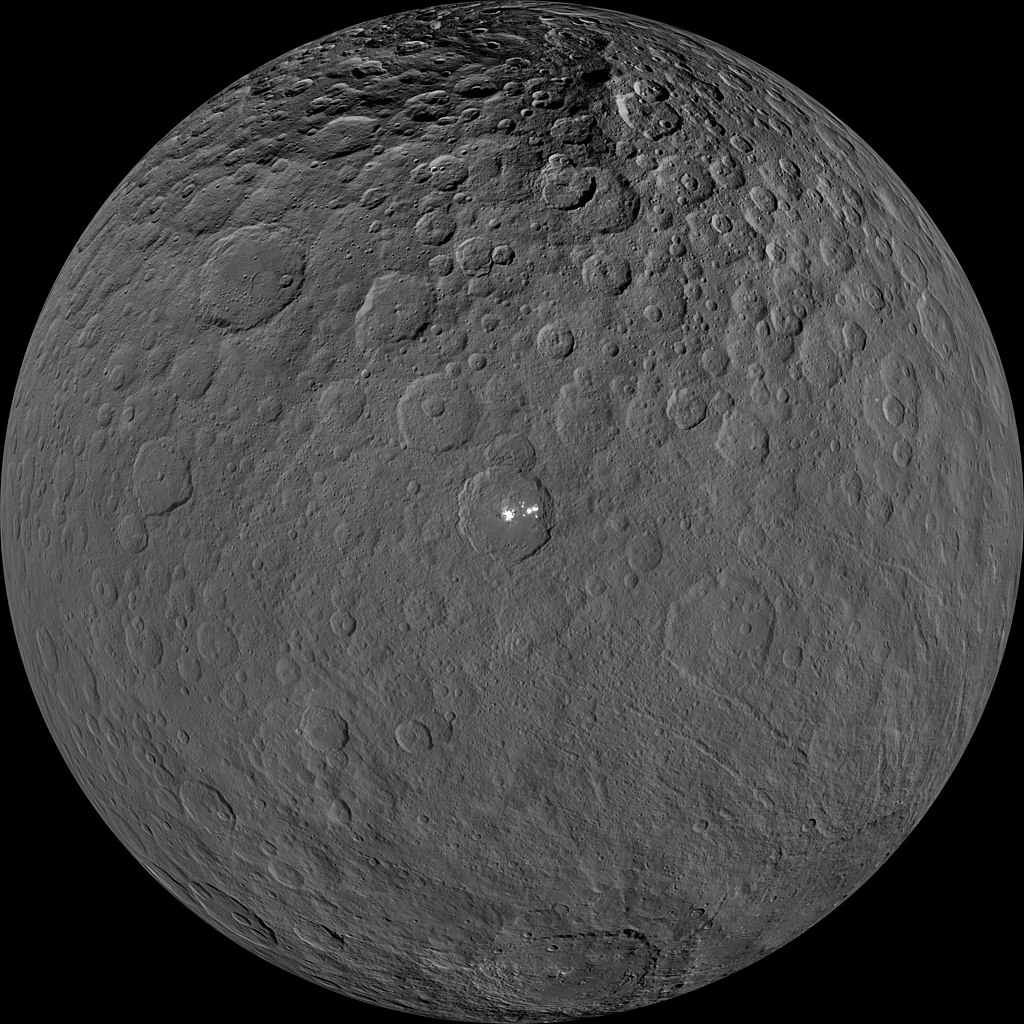
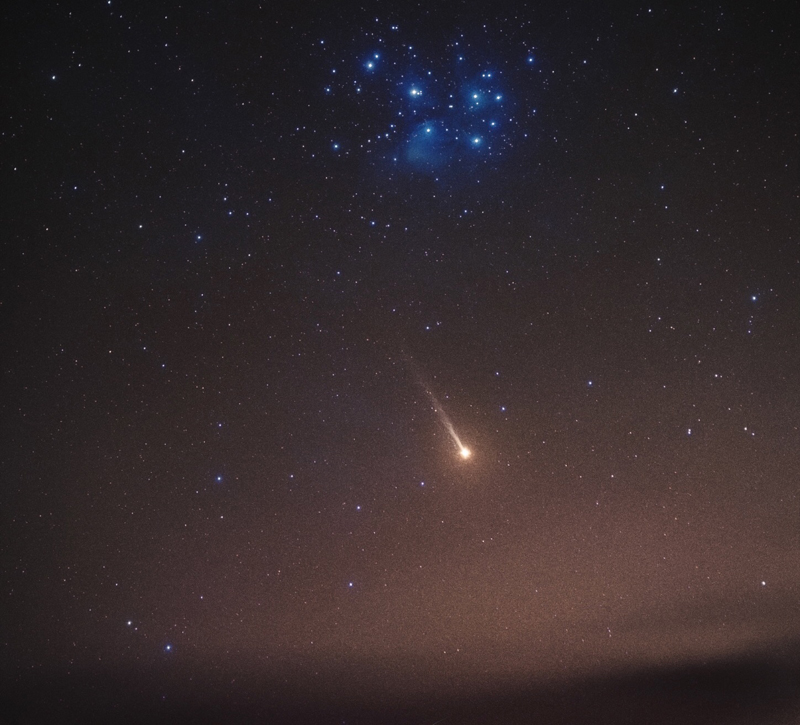 Two objects that I have observed numerous times over several decades and that have exhibited "cometary" activity but which I do not include as "comets" on my tally. LEFT: Composite image of the largest main-belt asteroid, (1) Ceres, obtained by NASA's Dawn spacecraft in 2017. Courtesy NASA. RIGHT: Mercury, with its sodium tail, and the Pleiades star cluster M45, imaged with instrumentation specifically sensitive to the light of sodium atoms, from La Palma in the Canary Islands by German photographer and amateur astronomer Sebastian Voltmer on April 27, 2022. Courtesy Sebastian Voltmer.
Two objects that I have observed numerous times over several decades and that have exhibited "cometary" activity but which I do not include as "comets" on my tally. LEFT: Composite image of the largest main-belt asteroid, (1) Ceres, obtained by NASA's Dawn spacecraft in 2017. Courtesy NASA. RIGHT: Mercury, with its sodium tail, and the Pleiades star cluster M45, imaged with instrumentation specifically sensitive to the light of sodium atoms, from La Palma in the Canary Islands by German photographer and amateur astronomer Sebastian Voltmer on April 27, 2022. Courtesy Sebastian Voltmer.
In any event, by the time all was said and done on the morning of September 30, I had added a more conventional comet to my tally . . .
INITIAL OBSERVATION: 2022 September 30.42 UT, m1 = 13.7, 0.4' "coma," DC = 8.5 (41 cm reflector, 70x)
UPDATE (October 20, 2022): According to a recent announcement from NASA, the DART impact changed Dimorphos' orbital period around Didymos by a rather significant 32 minutes -- quite a bit larger than what would have been considered "succesful," and near the upper range of what was considered possible. Based upon this one test, at least, it would appear that kinetic impact could be a viable method of deflecting a potentially incoming asteroid from impacting Earth (provided that we have enough lead time of its impending arrival).
Due in large part to weather and to moonlight, I have not attempted to observed Didymos again following my initial observation on September 30. The reports I have read indicate that it has returned to close to its pre-impact brightness, and at this writing is about 15th magnitude. Since it should continue fading as it recedes from Earth and furthermore is traveling through dense star fields near the Galactic Equator in Monoceros, it is rather unlikely I will look for it again. Meanwhile, in various images I have seen (including some recent ones I have taken via the Las Cumbres Observatory network) Didymos continues to exhibit a sharp and distinct tail that comes from dust ejected off Dimorphos' surface by the DART impact.
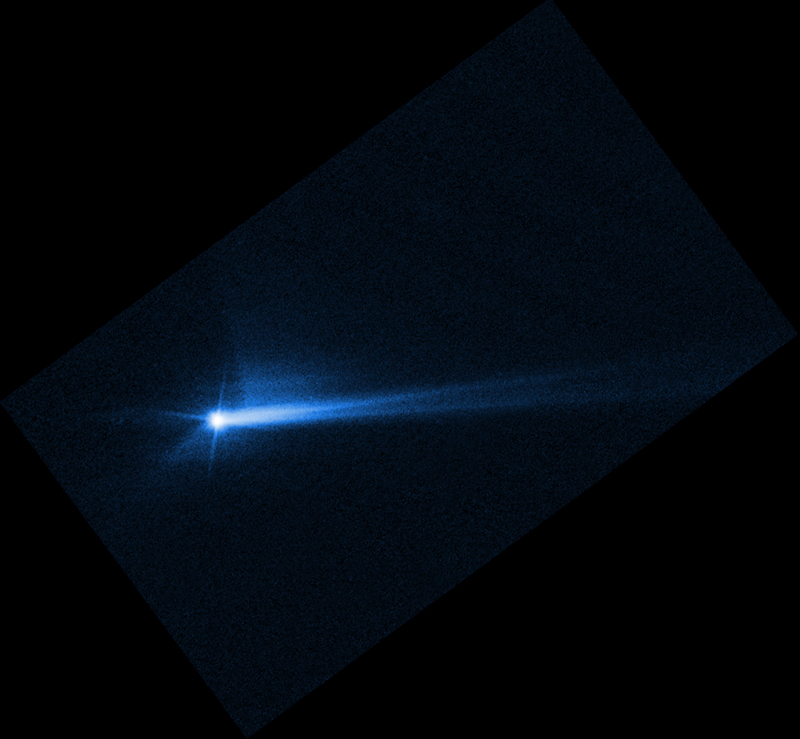
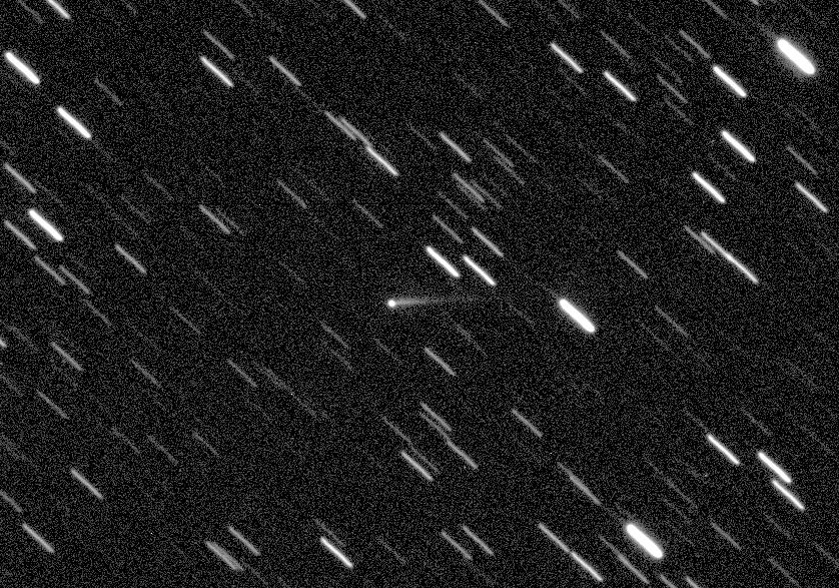 LEFT: An image of Didymos obtained by the Hubble Space Telescope on October 8, 2022, slightly less than 12 days after the DART impact. Courtesy NASA/ESA. Right: An image of Didymos I obtained via the Las Cumbres Observatory facility at Teide Observatory in the Canary Islands on October 17, 2022, almost three weeks after the DART impact.
LEFT: An image of Didymos obtained by the Hubble Space Telescope on October 8, 2022, slightly less than 12 days after the DART impact. Courtesy NASA/ESA. Right: An image of Didymos I obtained via the Las Cumbres Observatory facility at Teide Observatory in the Canary Islands on October 17, 2022, almost three weeks after the DART impact.
726. COMET ATLAS C/2022 R2 Perihelion: 2022 October 25.22, q = 0.633 AU
On the morning of September 30, 2022, for the 39th time I added two or more comets to my tally on the same night. As I was finishing up my observation of (65803) Didymos (no. 725) I saw that some clouds were approaching from the south, and before long these covered up the sky. I believed I was probably done for the night, but since I had a couple of other comets on my agenda I decided to wait and see if there might be any clearing, and, sure enough, about an hour later I saw that the sky in the northeast had indeed cleared, and I decided to attempt this recently-discovered comet. I managed to see a very faint and small slightly non-stellar object close to the comet's expected position, but unfortunately the northeastern sky clouded back over again within a few minutes, and I was unable to detect any motion or make an accurate brightness measurement. (The value I report at the end of this entry is a "guesstimate" from memory.) A precise positional check for the exact time of my observation -- the comet's motion at the time being two degrees per day -- and some Las Cumbres Observatory images I obtained half an hour after my observation confirmed for me that I had indeed seen the comet.
The comet was discovered by the ATLAS program in Hawaii on September 14, 2022, at which time it was around 17th magnitude. Calculations have revealed that it is traveling in a moderately-inclined direct orbit (inclination 53 degrees) that will soon carry it into the dawn and onto the far side of the sun as seen from Earth. Various images I have seen, including some I have taken via the Las Cumbres Observatory network, have indicated that Comet ATLAS has been brightening rapidly since its discovery, and this is what primarily motivated me to make my attempt for it on the morning of the 30th.
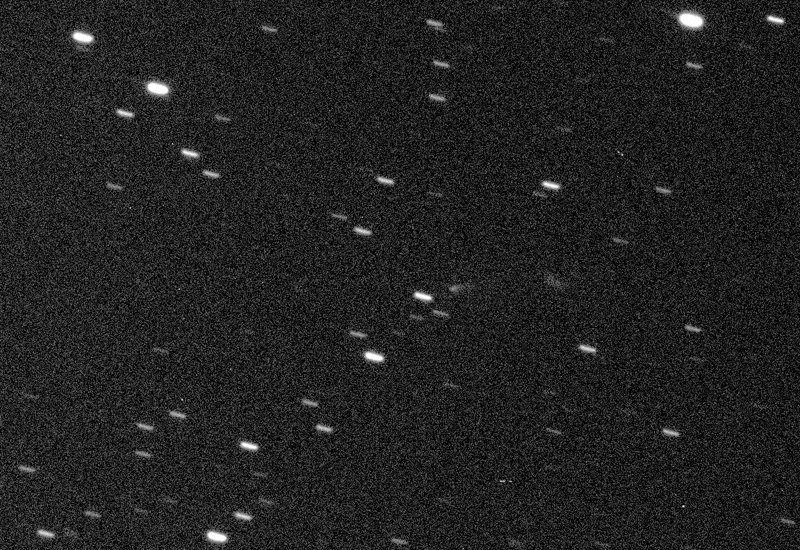
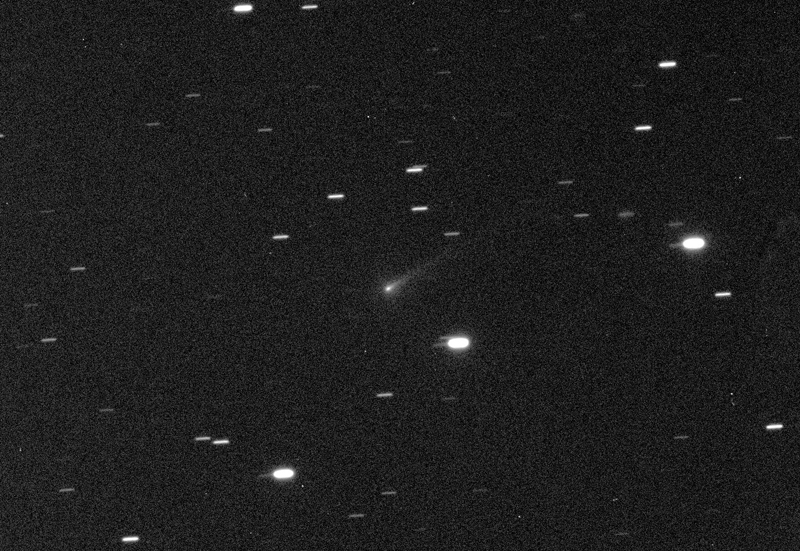 Images of Comet ATLAS I took via the Las Cumbres Observatory facility at McDonald Observatory in Texas that illustrate its rapid rise in brightness over a period of two weeks. Both are 3-minute exposures with 0.4-meter telescopes. LEFT: September 16, 2022, two days after its discovery. RIGHT: September 30, 2022, half an hour after my visual observation.
Images of Comet ATLAS I took via the Las Cumbres Observatory facility at McDonald Observatory in Texas that illustrate its rapid rise in brightness over a period of two weeks. Both are 3-minute exposures with 0.4-meter telescopes. LEFT: September 16, 2022, two days after its discovery. RIGHT: September 30, 2022, half an hour after my visual observation.
Comet ATLAS has just passed its closest to Earth (1.02 AU). It is presently located in northern Leo some five degrees northeast of the star Zeta Leonis, at a current elongation near 44 degrees; it continues traveling two degrees per day, at present mainly due eastward, although curving more towards the southeast during the next couple of weeks. By mid-October the elongation will have decreased to 36 degrees (at which time the comet will be passing some three degrees south of the Coma Berenices star cluster Melotte 111); this drops below 30 degrees during the last week of October and below 20 degrees in mid-November, reaching a minimum of 17 degrees in early December. The elongation gradually increases after that but remains small for quite some time, not going above 30 degrees until the second week of January 2023 and not above 40 degrees until shortly before the end of that month. By that time the comet is likely to be very faint and well beyond the range of visual observations.
Unfortunately, it appears that my brief observation of Comet ATLAS on September 30 may well remain my only observation of it. As of this writing a few days later I have not had another clear morning, and the weather forecasts are indicating clouds and rain for the next several days, at the end of which time the moon will be full. By the time I have a reasonably dark morning sky again the comet will probably be too close to the sun for me to observe. That's the way things go, sometimes . . .
INITIAL OBSERVATION: 2022 September 30.47 UT, m1 = 14.2:, 0.4' coma, DC = 7 (41 cm reflector, 229x)
727. COMET 81P/WILD 2 Perihelion: 2022 December 15.62, q = 1.598 AU
During the over five decades that I have been visually observing comets it comes as no surprise that there are quite a few periodic comets that I have now seen on multiple returns. The champion object in this regard is Comet 2P/Encke, with its short orbital period of 3.3 years, that I have observed on 13 separate returns, most recently two years ago (no. 683), and that I hope to see again when it has a moderately favorable return a year from now. Up until just now there were three comets that I had seen on seven separate returns, two of these being 19P/Borrelly and 45P/Honda-Mrkos-Pajdusakova -- both of which I have seen on returns this year (nos. 711 and 718, respectively) -- and an additional eight comets that I have observed on six returns each. The third seven-return comet is 81P/Wild 2, which was discovered in 1978 and which is a rather interesting comet scientifically (as I discuss in its "Ice and Stone 2020" "Comet of the Week" presentation); I have now picked it up on its 8th return, which puts it all alone in 2nd Place on the list of most returns at which I have observed a periodic comet. Indeed, I have managed to observe it during every return it has made throughout the course of my lifetime.
I observed Comet 81P on its 2010 return (no. 463) during the course of "Countdown" and I discuss its history, and my overall history with it, in its entry there. That particular return was the best one of it I have seen thus far, and I ended up following it for over ten months as it reached a peak brightness of magnitude 9 1/2 (and visibility in 10x50 binoculars) around the time of perihelion and opposition. I mentioned near the end of that entry that the subsequent return in 2016 was a relatively unfavorable one, but I nevertheless ended up following it for slightly over five months (no. 590) and it brightened to about magnitude 11 1/2 as it began disappearing into evening twilight a month and a half before perihelion passage.
On its present return Comet 81P was recovered as long ago as September 17, 2020, by the Pan-STARRS survey in Hawaii, at which time it was reported as being a very faint object of 22nd magnitude. It began to be followed in earnest about a year later, and numerous observations from around the world were reported as it went through opposition in mid-November 2021; it was reported as being close to 17th magnitude when it began disappearing into evening twilight around mid-April 2022. After being in conjunction with the sun near the end of June it began emerging into the morning sky about a month or so ago, and when I made my first attempt for it on the morning of October 26 -- at which time its elongation was 41 degrees -- I successfully detected it as a small and moderately condensed object slightly brighter than 13th magnitude.
The current return is virtually identical to that of 1990 (no. 146), the respective perihelion dates being just one day apart. During that return it reached a peak brightness near 12th magnitude when close to perihelion passage, but faded only gradually -- by about one magnitude -- as it approached opposition the following June (shortly after which I stopped following it). I have every reason to suspect something similar this time around, with closest approach to Earth (1.22 AU) taking place just after mid-May 2023 and opposition occurring in mid-June. Throughout this time it travels generally toward the east-southeast, from its present location in southeastern Leo through Virgo, Libra, northern Scorpius, Ophiuchus (passing just over half a degree south of the globular star cluster M9 on March 15, at which time it is at its (temporary) farthest south declination of -19 degrees), and northwestern Sagittarius, where it passes through its stationary point during the last week of April. Afterwards it travels westward back into Ophiuchus -- passing just over ten arcminutes north of M9 on June 12 -- and goes through its other stationary point during the fourth week of July. From that point onward it travels again towards the east-southeast, but will likely have faded beyond the point of visual detectability by that time. Since I am not as active as I was during the return of 1990-91 -- when, coincidentally, I was almost exactly half my present age -- I will likely not be observing the comet as frequently or for as long as I did then, but I should still nevertheless get a decent run of observations this time around.
While, as I've indicated, I've observed Comet P/Wild 2 at every return it has made during my lifetime, the present return comes as I am winding down my visual observational activities, and it entirely likely that this will be the final return at which I will see it. However, the next return, in 2029 -- perihelion in mid-May -- is a relatively favorable one, quite similar to that of 1997 (no. 223), when it became slightly brighter than 10th magnitude and, incidentally, shared the sky with Comet Hale-Bopp (no. 199). I will be 71 years old then, and depending upon what level of activity, if any, I may be exhibiting at that point, I suppose it is conceivable that I might grab an additional few observations of it. At this stage of my life I am pretty much taking each day as it comes, and there is quite a bit of uncertainty of anything beyond my relatively near-term future, but if I do happen to remain involved in astronomical activities at that time it might be interesting to check in on this comet that has been a regular visitor throughout almost all of my entire adult life.
INITIAL OBSERVATION: 2022 October 26.48 UT, m1 = 12.7, 0.6' coma, DC = 4-5 (41 cm reflector, 70x)
728. COMET PANSTARRS C/2022 A2 Perihelion: 2023 February 18.26, q = 1.735 AU
Since becoming operational in 2010 the Panoramic Survey Telescope and Rapid Response System (Pan-STARRS) program in Hawaii has become the most productive ground-based comet discovery program in history, having discovered as of this writing 283 named comets (under the assumption that my counting is correct) -- surpassing the total of the no-longer-operational LINEAR program, which had 223 named comet discoveries (again, under the assumption that my counting is correct). The overwhelming majority of Pan-STARRS' comet discoveries have been very faint objects of 20th or 21st magnitude that never became much brighter; indeed, only two PANSTARRS comets have reached naked-eye brightness (and only one of these, C/2011 L4 (no. 504), was visible as such from the northern hemisphere), and only a handful of others even became bright enough to detect with binoculars. This present comet is the 27th comet I have seen with the name "PANSTARRS," which means that I have observed roughly 10% of the survey's discoveries. (For what it's worth, "LINEAR" remains the most common name on my tally, with 74 entries at this time; Rob McNaught, who made most of his discoveries via the no-longer-operational Siding Spring Survey based in New South Wales, has 28 entries on my tally, which puts "PANSTARRS" currently in 3rd place -- although probably not for long).
This Comet PANSTARRS was discovered on January 10, 2022, and like most of the program's discoveries was a faint object of 20th magnitude at that time. It had brightened to about 18th magnitude by late June, by which time it was starting to enter evening twilight, and after being in conjunction with the sun in early September began emerging into the morning sky about a month later. Some of the reports I read and images I saw suggested that it might soon be bright enough to attempt visually, so after waiting for the moon to clear from the morning sky I looked for it on the morning of November 22, and easily saw it as a diffuse moderately condensed object of magnitude 11 1/2.
The comet is traveling in a steeply-inclined retrograde orbit (inclination 108 degrees). It is presently located in southern Canes Venatici some three degrees east-northeast of the star Beta Comae Berenices, and is traveling towards the east-northeast, currently at a little over half a degree per day but increasing to a maximum of just over 70 arcminutes a day when it is nearest Earth (1.61 AU) in mid-January 2023. Throughout this time it remains in the morning sky, traveling through Canes Venatici, Bootes, Hercules, and Draco; by the latter part of January it enters northern circumpolar skies, reaching a maximum declination of +58.7 degrees just before the end of that month. Shortly after mid-February, as it nears perihelion passage, it enters an extended period of conjunction with the sun (on the far side of the sun as seen from Earth), initially about 64 degrees north of it but dropping to under 45 degrees by the latter part of March. While the comet does start to emerge more directly into the morning sky after that its elongation remains small for quite some time thereafter, reaching a minimum of 36 degrees in mid-April, not going above 40 degrees until mid-May, and not above 50 degrees until early June. Based upon its present brightness Comet PANSTARRS may reach a peak brightness near 10th magnitude in late January and early February, and may still be around 12th magnitude when it becomes easily accessible again in June -- when it will be located in southern Andromeda some five degrees southeast of the Andromeda Galaxy M31 -- but it will likely fade beyond visual range not too long thereafter.
INITIAL OBSERVATION: 2022 November 22.48 UT, m1 = 11.5, 1.8' coma, DC = 3-4 (41 cm reflector, 70x)
UPDATE (May 30, 2023): I followed Comet PANSTARRS on an occasional basis up through early March 2023, and -- to my eyes, anyway -- it reached a peak brightness between magnitudes 10 1/2 and 11, although it's fair to note that some other observers -- primarily those located at more northerly latitudes than mine, who were able to observe it at higher altitudes above the horizon -- reported it as being up to a magnitude or so brighter. As I indicate above, after early March it went into an extended conjunction with the sun, which essentially made it inaccessible for me, although, again, observers at more northerly latitudes were able to keep following it. It has finally become accessible for me again, and on the morning of May 29 I successfully observed it as a moderately condensed object of 12th magnitude.
The comet is presently located in south-central Andromeda two degrees south-southwest of the star Mu Andromedae and five degrees south-southeast of the Andromeda Galaxy M31, and is traveling relatively slowly -- approximately 8 arcminutes per day -- in a generally southerly direction. It is now over three months past perihelion passage, and although approaching Earth again for the time being -- closest approach being a somewhat distant 2.04 AU on August 30 -- I suspect it will fade gradually over the coming weeks, and I will likely only observe it a few more times, at most.
MOST RECENT OBSERVATION: 2023 May 29.42 UT, m1 = 12.0, 1.3' coma, DC = 3-4 (41 cm reflector, 70x)
729. COMET ATLAS C/2022 U2 Perihelion: 2023 January 14.22, q = 1.328 AU
On the evening of December 15, 2022, for the second time in 2022 and the 40th time overall I added two or more comets to my tally on the same night. Curiously, this came exactly two years after another two-comet-add night (nos. 691 and 692) and, even more curiously, on both occasions both comets involved are discoveries of the ATLAS program based in Hawaii. I am still following the second of the two 2020-added comets (C/2019 L3 (no. 692)), as it is currently 12th magnitude in my southern morning sky, although as I indicated in my recent note to its tally entry I don't expect to be following it for too much longer.
ATLAS discovered this particular comet on October 25, 2022. A set of images I took via the Las Cumbres Observatory network five days later -- the astrometric measurements from which are included on the comet's discovery announcement -- showed it as a faint, slightly non-stellar object between 18th and 19th magnitude, a brightness that is consistent with most of the other observations that were being reported at the time. However, some deep images seemed to show a large, vague and diffuse outer coma that has persisted and brightened since then, and recent images of the comet I have seen suggested that it was now bright enough to be worth attempting visually. When I did so on the evening of December 15 I successfully detected it as a vague, diffuse object of magnitude 12 1/2.
According to the most recent calculations Comet ATLAS is an intermediate-period type object with an approximate orbital period of 950 years, and is traveling in a moderately-inclined direct orbit (inclination 48 degrees). It is presently in northern circumpolar skies near a declination of +71 degrees and located in eastern Draco one degree north-northwest of the star Epsilon Draconis, traveling towards the northeast at a current rate of half a degree per day. Over the coming few weeks it accelerates and gradually curves more directly eastward, crossing into Cepheus shortly before the end of December and reaching a peak northerly declination of +77.6 degrees on January 8, 2023 and passing just five arcminutes south of the future North Pole Star Gamma Cephei the following day (at which time it will be traveling at close to 70 arcminutes per day). Now traveling towards the south-southeast, over the next six weeks the comet travels through northern Cassiopeia, Camelopardalis, northeastern Perseus, Auriga, and eastern Taurus, being closest to Earth (0.56 AU) on January 28, at which time it is traveling at its peak rate of slightly under two degrees per day. Afterwards it slows down and continues its southward travels through northeastern Orion and (beginning in mid-March) Monoceros as it recedes from Earth and the sun.
Ostensibly Comet ATLAS should brighten by perhaps a magnitude or slightly more by the time it is closest to Earth. However, a rapid brightening as perihelion is approached is not especially unusual for intermediate-period comets, so a peak brightness of about 10th magnitude might be a reasonable expectation. Afterwards it might remain visually detectable until perhaps sometime in April.
Around 19 hours UT on February 6, Comet ZTF C/2022 E3 (no. 722) passes 20 arcminutes east of Comet ATLAS, the encounter itself taking place just over a degree south of the unusual eclipsing binary star Epsilon Aurigae. At that time Comet ZTF will be just a few days past its closest approach to Earth (and still located at a geocentric distance of 0.33 AU); it will be traveling almost due southward at 5 degrees per day, and may be a naked-eye object of 5th or 6th magnitude. Unfortunately, this encounter takes place only one day after full moon and will be a difficult event to view visually, although it should make for some interesting images. (Even without the moonlight, the event is rather moot for me anyway, since by the time darkness falls here in New Mexico the separation between the two comets will have increased to almost one degree.)
INITIAL OBSERVATION: 2022 December 16.09 UT, m1 = 12.5, 1.9' coma, DC = 1 (41 cm reflector, 70x)
730. COMET ATLAS C/2021 Y1 Perihelion: 2023 April 30.71, q = 2.032 AU
Just over half an hour after adding the previous comet to my tally, I turned my telescope over to high in my southern sky and added this one. The ATLAS survey discovered this comet on December 26, 2021, although pre-discovery images taken by amateur astronomer Mike Holbrook in Alabama on two nights the previous month were later identified. At the time of its discovery Comet ATLAS was a relatively faint object of 18th or 19th magnitude and was located at a heliocentric distance of 5.5 AU. It has gradually and steadily brightened since then, and recent images I've seen have shown a distinct tail and have suggested that it is now bright enough for visual attempts. When I looked for it on the evening of December 15 I successfully detected it as a small and relatively condensed object of 14th magnitude.
Comet ATLAS is traveling in a relatively steeply-inclined direct orbit (inclination 77 degrees). It went through opposition in late November and was at its closest to Earth (1.69 AU) three days before my first observation. It is currently located in southwestern Taurus four degrees northeast of the star 10 Tauri and is traveling towards the southwest at approximately half a degree per day; it crosses into Eridanus in late December, where it remains for the next four months before finally crossing into southwestern Lepus in early May 2023, and in the meantime it goes through its stationary point in early February and thereafter travels primarily towards the east-southeast. The comet's increasingly southward location will start to render it inaccessible from my latitude after about late March (when its declination will be close to -20 degrees), although observers in the southern hemisphere should be able to access it for quite some time thereafter. Its decreasing heliocentric distance should offset its increasing distance from Earth, and thus its brightness may remain relatively unchanged over the next few months, although because of its overall faintness I will probably not be making many observations of it.
For a point of trivia, my addition of this Comet ATLAS to my tally marks the 22nd consecutive year during which I have observed at least one comet with a perihelion passage during the calendar month of April. Provided that I am able to remain active, I should be able to extend that string for one more year, since Comet 12P/Pons-Brooks, which was recovered back in June 2020 and which I successfully imaged via the Las Cumbres Observatory network this past October, passes perihelion on April 21, 2024. Should I succeed in my lifelong quest to observe a Kreutz sungrazer (or other comet) during totality of a solar eclipse during the eclipse on April 8 of that year, that would also (presumably) involve an April perihelion passage. That will probably end this particular string since, as I've indicated in numerous previous entries, I will likely "retire" from visual comet observing later that year. While I have also indicated that I might "come out of retirement" for bright or otherwise interesting comets after that point, at this writing there aren't any known such April-perihelion comets for the next several years thereafter.
INITIAL OBSERVATION: 2022 December 16.11 UT, m1 = 14.0, 0.6' coma, DC = 4 (41 cm reflector, 229x)
<-- Previous
Next -->
BACK to Comet Resource Center